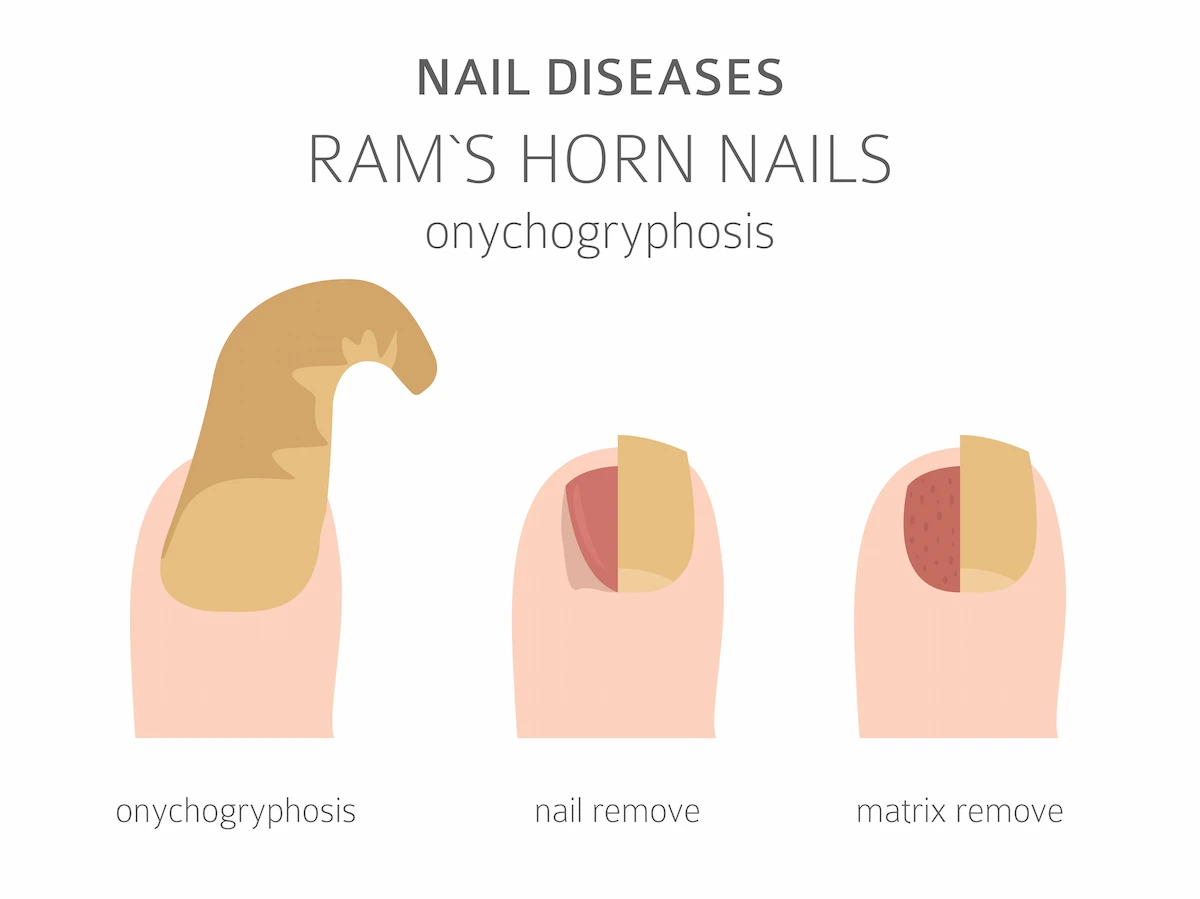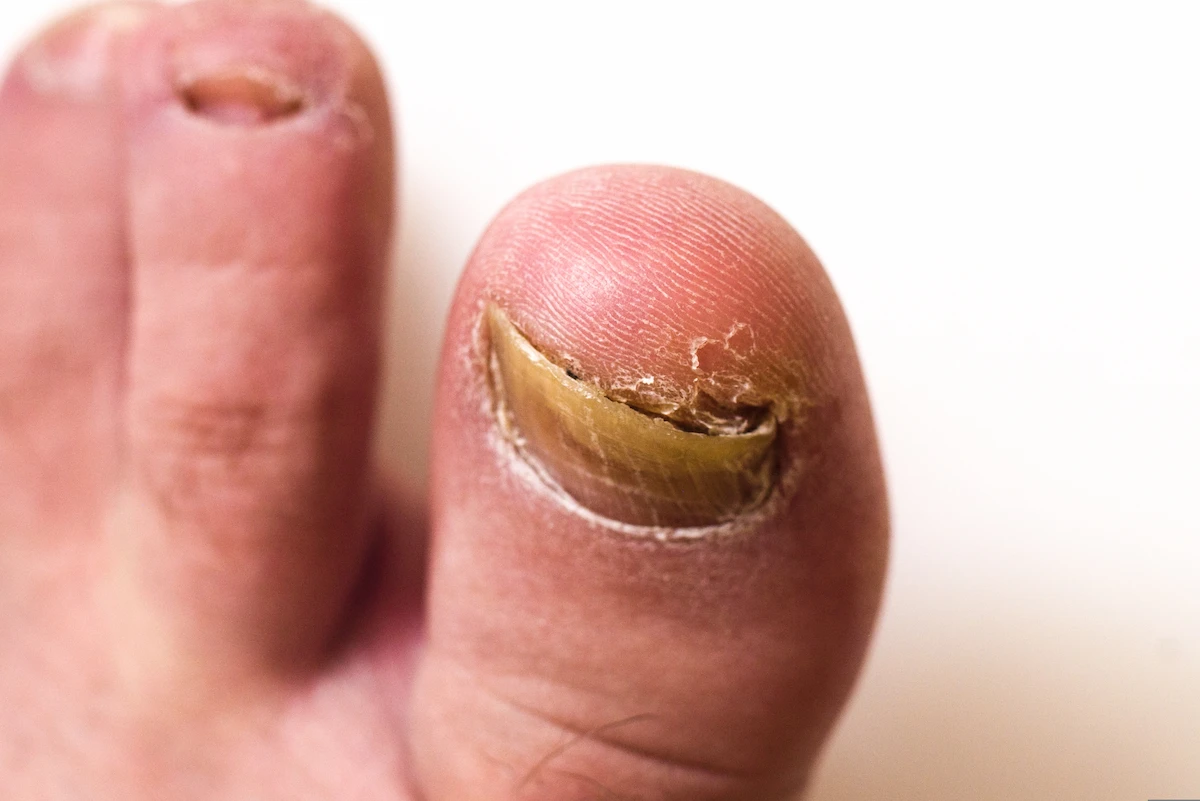Onychogryphosis: Understanding Ram’s Horn Nails

Onychogryphosis, commonly known as ram’s horn nails, is a nail disorder characterized by thickened, curved, and often discolored nails. This condition can cause significant discomfort and impact quality of life. In Miami, understanding onychogryphosis and seeking timely medical attention is crucial for effective management.
What is Onychogryphosis? A Nail Disorder Explained
Onychogryphosis is a hypertrophy of the nails, typically affecting the toenails, although it can also occur in fingernails. The nails become thickened, elongated, and curved, resembling a ram’s horn.
Causes of Onychogryphosis: Factors Contributing to the Condition
Several factors can contribute to the development of onychogryphosis:
- Trauma: Repeated injury to the nail bed can lead to abnormal nail growth.
- Aging: Natural nail growth slows and thickens with age, increasing susceptibility.
- Poor Circulation: Conditions like peripheral artery disease can impair blood flow to the extremities.
- Fungal Infections: Chronic fungal infections can contribute to nail thickening and discoloration.
- Psoriasis: This skin condition can affect nail growth.
- Genetic Predisposition: In some cases, onychogryphosis may be inherited.
- Neglected Nail Care: Infrequent trimming or improper nail care can worsen the condition.
Discolored Toenail: Recognizing the Visual Changes
Discolored toenail is a common symptom of onychogryphosis. Nails can appear yellow, brown, or even black due to thickening, debris buildup, or fungal infections.
Black Toenail: Distinguishing Between Causes
A black toenail can result from various factors, including:
- Subungual Hematoma: Blood trapped under the nail due to trauma.
- Fungal Infection: Fungal infections can cause darkening of the nail.
- Onychogryphosis: The thickening and discoloration associated with onychogryphosis can result in a black appearance.
Black Toenail Fungus: A Common Culprit
Black toenail fungus can contribute to nail discoloration and thickening. It’s crucial to differentiate between fungal infections and other causes of black toenails.

Nail Mold vs Fungus: Understanding the Difference
Nail mold vs fungus can be difficult to distinguish. Both can cause nail discoloration and changes. However, mold typically affects the surface of the nail, while fungus penetrates deeper.
Symptoms of Onychogryphosis: Identifying the Signs
- Thickened and elongated nails.
- Curved, ram’s horn-like appearance.
- Discoloration (yellow, brown, black).
- Pain or discomfort, especially with pressure.
- Difficulty trimming nails.
- Ingrown nails.
Treatment Options for Onychogryphosis: Addressing the Condition
Treatment for onychogryphosis depends on the severity and underlying cause:
- Regular Nail Trimming: Professional nail trimming by a podiatrist is essential.
- Nail Softening Agents: Topical medications can soften the nails, making them easier to trim.
- Oral or Topical Antifungal Medications: For fungal infections.
- Nail Avulsion: In severe cases, surgical removal of the nail may be necessary.
- Treatment of Underlying Conditions: Addressing conditions like poor circulation or psoriasis.
Primary Doctor in Miami: Your First Step to Nail Health
If you’re experiencing symptoms of onychogryphosis or have concerns about your toenails, consulting a primary doctor in Miami is advisable. They can:
- Perform a physical examination.
- Assess your symptoms.
- Recommend appropriate treatment options.
- Refer you to a podiatrist or dermatologist if necessary.
Key Takeaways:
- Onychogryphosis is a nail disorder characterized by thickened, curved, and discolored nails.
- Various factors can contribute to the condition, including trauma, aging, and fungal infections.
- Treatment options range from regular nail trimming to surgical intervention.
- Consult a primary doctor in Miami for evaluation and treatment.
Remember, this article is for informational purposes only and does not replace professional medical advice. Always consult with a qualified healthcare provider for diagnosis and treatment.
FAQs: Onychogryphosis
- Is onychogryphosis contagious?
Onychogryphosis itself is not contagious. However, if it’s caused by a fungal infection, that infection can be contagious and may spread to other nails or people. - Can I treat onychogryphosis at home?
While you can trim your nails at home, onychogryphosis often requires professional nail care from a podiatrist. They can safely and effectively trim thickened nails and address any underlying causes. - What are the risks of leaving onychogryphosis untreated?
Untreated onychogryphosis can lead to pain, infection, ingrown toenails, and difficulty walking. In severe cases, it can also impact your quality of life. - Are there any ways to prevent onychogryphosis?
While some causes, like aging or genetics, are unavoidable, you can reduce your risk by:- Practicing proper nail care
- Wearing comfortable and well-fitting shoes
- Protecting your nails from trauma
- How can a primary care doctor help with onychogryphosis? A primary care doctor in Miami can assess your symptoms, rule out any underlying medical conditions, and refer you to a podiatrist or dermatologist for specialized nail care. They can also help manage any related health concerns, such as poor circulation.
Contact Us
Hiriart & Lopez MD, LLC
9950 SW 107th Ave STE 101,
Miami, FL 33176
305-274-8779
Phone: (305) 274-8779
Fax: (305) 274-0646
OPENING HOURS
Monday 7:30 AM–4:30 PM
Tuesday 7:30 AM–4:30 PM
Wednesday 7:30 AM–4:30 PM
Thursday 7:30 AM–4:30 PM
Friday 7:30–11 AM
Saturday Closed
Sunday Closed
OFFICE LOCATION
Onychogryphosis: Understanding Ram’s Horn Nails

Onychogryphosis, commonly known as ram’s horn nails, is a nail disorder characterized by thickened, curved, and often discolored nails. This condition can cause significant discomfort and impact quality of life. In Miami, understanding onychogryphosis and seeking timely medical attention is crucial for effective management.
What is Onychogryphosis? A Nail Disorder Explained
Onychogryphosis is a hypertrophy of the nails, typically affecting the toenails, although it can also occur in fingernails. The nails become thickened, elongated, and curved, resembling a ram’s horn.
Causes of Onychogryphosis: Factors Contributing to the Condition
Several factors can contribute to the development of onychogryphosis:
- Trauma: Repeated injury to the nail bed can lead to abnormal nail growth.
- Aging: Natural nail growth slows and thickens with age, increasing susceptibility.
- Poor Circulation: Conditions like peripheral artery disease can impair blood flow to the extremities.
- Fungal Infections: Chronic fungal infections can contribute to nail thickening and discoloration.
- Psoriasis: This skin condition can affect nail growth.
- Genetic Predisposition: In some cases, onychogryphosis may be inherited.
- Neglected Nail Care: Infrequent trimming or improper nail care can worsen the condition.
Discolored Toenail: Recognizing the Visual Changes
Discolored toenail is a common symptom of onychogryphosis. Nails can appear yellow, brown, or even black due to thickening, debris buildup, or fungal infections.
Black Toenail: Distinguishing Between Causes
A black toenail can result from various factors, including:
- Subungual Hematoma: Blood trapped under the nail due to trauma.
- Fungal Infection: Fungal infections can cause darkening of the nail.
- Onychogryphosis: The thickening and discoloration associated with onychogryphosis can result in a black appearance.
Black Toenail Fungus: A Common Culprit
Black toenail fungus can contribute to nail discoloration and thickening. It’s crucial to differentiate between fungal infections and other causes of black toenails.

Nail Mold vs Fungus: Understanding the Difference
Nail mold vs fungus can be difficult to distinguish. Both can cause nail discoloration and changes. However, mold typically affects the surface of the nail, while fungus penetrates deeper.
Symptoms of Onychogryphosis: Identifying the Signs
- Thickened and elongated nails.
- Curved, ram’s horn-like appearance.
- Discoloration (yellow, brown, black).
- Pain or discomfort, especially with pressure.
- Difficulty trimming nails.
- Ingrown nails.
Treatment Options for Onychogryphosis: Addressing the Condition
Treatment for onychogryphosis depends on the severity and underlying cause:
- Regular Nail Trimming: Professional nail trimming by a podiatrist is essential.
- Nail Softening Agents: Topical medications can soften the nails, making them easier to trim.
- Oral or Topical Antifungal Medications: For fungal infections.
- Nail Avulsion: In severe cases, surgical removal of the nail may be necessary.
- Treatment of Underlying Conditions: Addressing conditions like poor circulation or psoriasis.
Primary Doctor in Miami: Your First Step to Nail Health
If you’re experiencing symptoms of onychogryphosis or have concerns about your toenails, consulting a primary doctor in Miami is advisable. They can:
- Perform a physical examination.
- Assess your symptoms.
- Recommend appropriate treatment options.
- Refer you to a podiatrist or dermatologist if necessary.
Key Takeaways:
- Onychogryphosis is a nail disorder characterized by thickened, curved, and discolored nails.
- Various factors can contribute to the condition, including trauma, aging, and fungal infections.
- Treatment options range from regular nail trimming to surgical intervention.
- Consult a primary doctor in Miami for evaluation and treatment.
Remember, this article is for informational purposes only and does not replace professional medical advice. Always consult with a qualified healthcare provider for diagnosis and treatment.
FAQs: Onychogryphosis
- Is onychogryphosis contagious?
Onychogryphosis itself is not contagious. However, if it’s caused by a fungal infection, that infection can be contagious and may spread to other nails or people. - Can I treat onychogryphosis at home?
While you can trim your nails at home, onychogryphosis often requires professional nail care from a podiatrist. They can safely and effectively trim thickened nails and address any underlying causes. - What are the risks of leaving onychogryphosis untreated?
Untreated onychogryphosis can lead to pain, infection, ingrown toenails, and difficulty walking. In severe cases, it can also impact your quality of life. - Are there any ways to prevent onychogryphosis?
While some causes, like aging or genetics, are unavoidable, you can reduce your risk by:- Practicing proper nail care
- Wearing comfortable and well-fitting shoes
- Protecting your nails from trauma
- How can a primary care doctor help with onychogryphosis? A primary care doctor in Miami can assess your symptoms, rule out any underlying medical conditions, and refer you to a podiatrist or dermatologist for specialized nail care. They can also help manage any related health concerns, such as poor circulation.
Contact Us
Hiriart & Lopez MD, LLC
9950 SW 107th Ave STE 101,
Miami, FL 33176
305-274-8779
Phone: (305) 274-8779
Fax: (305) 274-0646
OPENING HOURS
Monday 7:30 AM–4:30 PM
Tuesday 7:30 AM–4:30 PM
Wednesday 7:30 AM–4:30 PM
Thursday 7:30 AM–4:30 PM
Friday 7:30–11 AM
Saturday Closed
Sunday Closed

